No matter where your organization stands on the spectrum of AI understanding and adoption, the process of AI integration follows a fairly predictable path. Having a roadmap to shine a light on what needs to happen and when, is both calming and practical for a team of any size. Five steps for a smooth AI integration.
AI Leadership, Fiona Passantino, late February 2024
What’s your Maturity Bird?
We’re now in a second wave of AI; the secondary and tertiary tooling phase: a multitude of start-ups delivering tailored, user-friendly “wrapper apps” to the B2B world, some to consumers, all of which need to be tested, understood, evaluated against the needs and goals of the organization. And somebody has to find the time for all this.
Regardless of the maturity level of the organization, whether “Ostrich” or “Eagle” (see “Bird-Based AI Maturity Chart”), AI integration follows a fairly predictable pathway. Given the incredible speed at which new tech is shipping to market, this structure repeats itself over and over again with each development and new head-exploding-emoji hype cycle.
Having a roadmap to shine a light on what needs to happen and when, is both calming and practical for any organization of any size.
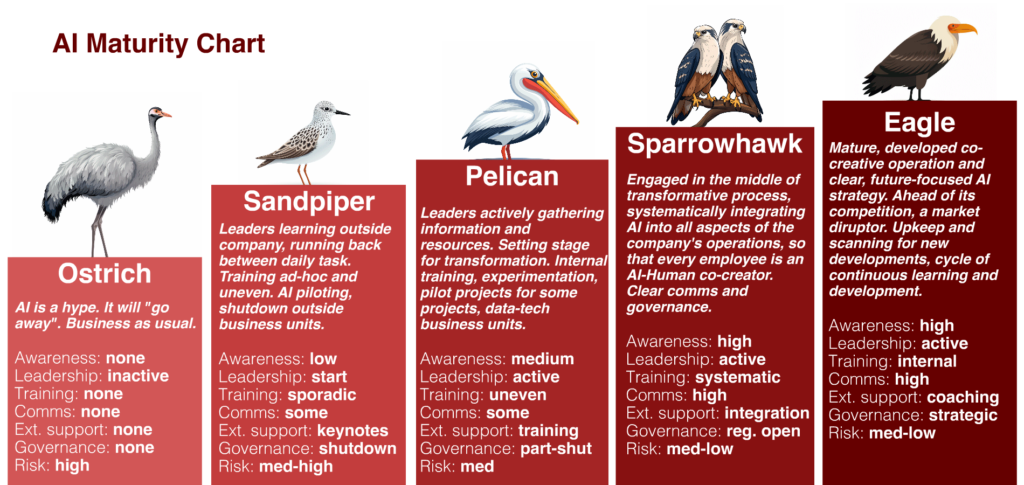
Step 1: Understanding
The cycle begins with a hard look within. What is our current level of understanding as an organization? Are we a “Sandpiper (running out sporadically to gather bits of information to bring back to the nest)” or an “Ostrich (head in the sand, AI doesn’t exist for me)” organization, and is our leadership committed to undergoing change? What pain are we experiencing; what processes are too time consuming, limiting, unwieldy? In short, “Human-driven”; are we experiencing customer churn based on our inability to offer personalized messaging? Are we losing talent or sales opportunities? And, is our current AI governance effectively protecting our data?
“Understanding” does not have to be a fully internal process, but one supported by an external expert. Most importantly, an external AI data security analyst is best positioned to examine the weak areas in a system, and give an unvarnished report. This phase is both outside-in and inside out: the time to hold internal awareness events with external speakers or dispatching internal teams to external industry AI events to scan for developments.
Documentation at this stage is key to map where the company is now, and where it hopes to arrive in six months’ time. This is also the time to have those difficult budget conversations; how great is the gap between our AI-readiness and that of our competition, and how much are we willing to invest in time and resources to close that gap?
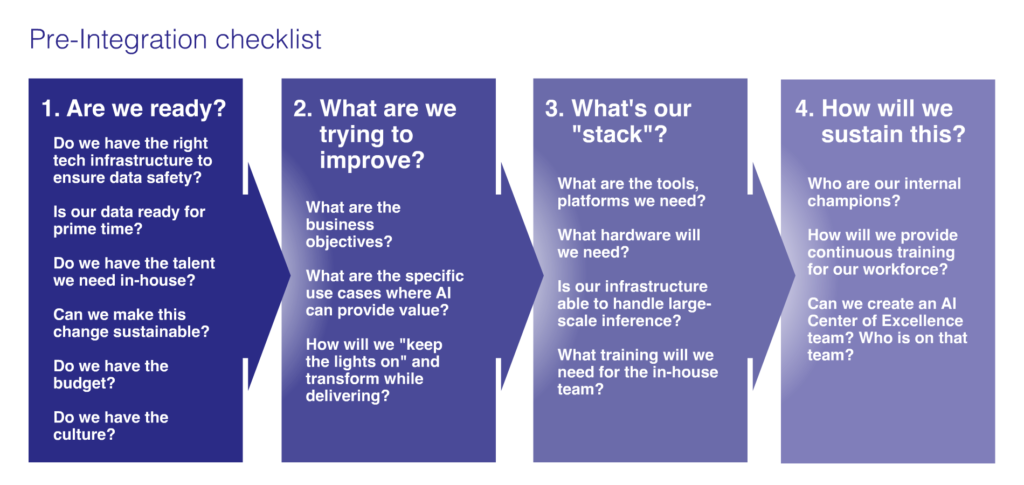
Step 2: Training
Whether you’re a C-suite executive or customer-facing sales operative, an AI training campaign is an “all-hands” undertaking. This is efficient – going layer by layer in the organization, for a full-day, on-location intensive training event – but also festive. AI Training Days should be fun and exciting, a time to connect, meet in person, and face the future together.
After a widespread training event, the chances are higher that everyone will share the same basic level of understanding of the risks and opportunities associated with AI, company-wide. This would include how to handle data and privacy, what an off-the-shelf solution offers and weighing this against the benefits of a behind-the-wall, embedded, engineered solution running inference on a local server with contextual customer data.
Everyone understands, simultaneously, why uploading customer data to an open-source, cloud-based server on the other side of the world has consequences for the customer, and why certain rules for AI usage are in place.
It will also allow the working community to set their sights on the future; share a vision of the AI-readiness goals together, and to appreciate how much more interesting, varied, creative and Human their AI-Powered roles will become in the weeks and months ahead. Shared goals mean increased engagement, and less resistance to implementation and change.
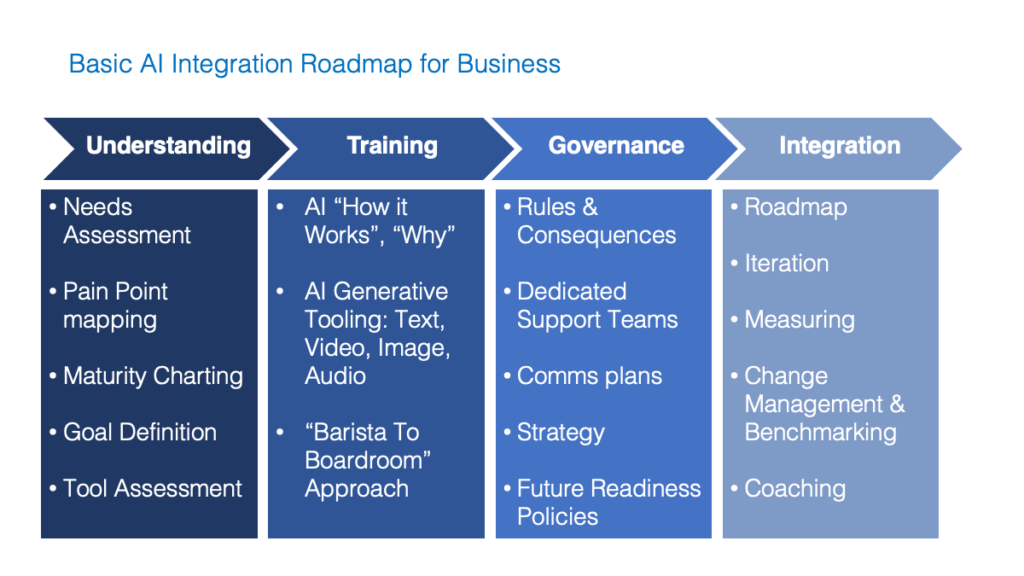
Step 3: Governance
No one likes rules; certainly not the Creative Rebels among us. But when dealing with a shape-shifting creature like AI, rules are necessary. Top-down, draconian, enforced, punishable and in effect starting yesterday. The worst kind of rules for the old-at-heart, the change averse and the external consultants who prefer their own rules.
With every level of AI maturity, no matter what bird your organization hatched from, there must be clear, well-communicated governance communicated widely, to every member of the organization, so there is no room for doubt.
An example of a typical “Pelican” organization governance document might be:
If you are currently working in the <IT, business intelligence, data engineering etc. department>, these rules do not apply.
Text AI:
- You must use <Company> premium enterprise subscription to Google Gemini without exception, effective immediately.
- No other text generative AI may be used for any purpose, including <ChatGPT, Pi, CoPilot etc.>
- The <company> Bard account is installed on your <company> machine, accessible by desktop widget. Double-click to open, and log on with your Single Sign On credentials.
- No other account except this one may be used for any reason for business or personal reasons, either on your <company> laptop or personal.
- Text AI may be used only for the following purposes:
- Internal communications restricted to <emails, newsletters, social posting, documentation, training materials, onboarding etc.>
- External communications, restricted to <product descriptions, translated communications, sales presentations, employer marketing, recruitment etc.>
- No business informational data may be uploaded to any AI prompt window for any reason.
- All AI-generated content passes through our company SharePoint, and is <located, dated, named> etc.
- All final text must be 100% Human-edited, rewritten, verified, native-checked, before release.
Image AI
- You must use <Company> premium enterprise subscription to Dal-E 3, via the <company> Gemini account. No other image AI may be used for any purpose, including <Midjourney, Sensei, Firefly etc.>
- The company Bard image AI widget is installed on your <company> machine, accessible by desktop. Double-click to open, and log on with your Single Sign On credentials. No other account except this one may be used for any reason for business or personal reasons.
- Image AI may be used only for the following purposes:
- Internal communications restricted to <emails, newsletters, social posting, documentation, training materials, onboarding etc.>
- External communications, restricted to <product descriptions, translated communications, sales presentations, employer marketing, recruitment etc.>
- No business imagery, employee portraits may be uploaded to any AI prompt window for any reason.
- All generated content passes through our company SharePoint, and is <located, dated, named> etc.
- All final imagery must be re-edited, verified, tagged and watermarked before release, internal or external.
Voice AI
- No member of <company>’s voice may be cloned for any reason.
- All audio samples of presentations, internal or external, are no longer able to reside on your personal SharePoint, but must be transferred to a secure company SharePoint: <located, dated, named> etc. these can be accessed against a request form only starting <date>.
- No original, high-resolution audio of any person in this company may be released to an insecure, external server for any reason, but will remain encrypted on <location> starting <date>.
Video AI
- No member of <company>’s video likeness may be cloned for any reason.
- All video samples of presentations, internal or external, are no longer able to reside on your personal SharePoint, but must be transferred to a secure company SharePoint: <located, dated, named> etc. these can be accessed against a request form only starting <date>.
- No original, high-resolution video of any person in this company may be released to an insecure, external server for any reason, but will remain encrypted on <location> starting <date>.
And so on…
Having a “Ten Commandments” document – a one-pager A4, posted everywhere, on every wall, sent around widely to every member of the organization – is not an extreme step to make sure AI governance is in place.
This phase will also see the creation of an AI Governance Team; made up of a mix of data engineers, security professionals, internal and external communicators, headed by a top-level executive champion. This team will be responsible for the AI Integration cycle – training, communicating, enforcing compliance, scanning for risks, learning about new developments in the field, and injecting their findings to the highest level of the organization to ensure a continuous flow of improvement.
Will there be issues, forgetfulness, poor judgement – in short, mistakes – along the path to Good AI Governance? Without a doubt: there is a 100% chance that the organization passes from one bird to the next without a few data breaches, near misses, oh-my-god-did-that-just-go-live bumps along the way. But in the absence of clear, no-exceptions governance in place, there is a 100% chance that very serious security and poor decision-making will result, landing the organization in a new world of pain: crisis communication.
Good AI governance does not have to be tyrannical, but an opportunity for fun, celebration and a bit of gamification. Imagine the AI Integration Team kicks off the new rules with a party, where everyone gets to play with the new tools in a “safe space”. Have some food, some fun, learning a bit in the process.
Imagine a company leader board that gives points. Find an unsecured company video of the CEO and redirect it the data security guys for encryption? 10 points! What about 2 points every time someone uploads Human-proofed AI text onto the secure, firewalled server? 5 points for every example of a rewritten AI-generated text? This makes it fun and gamified.
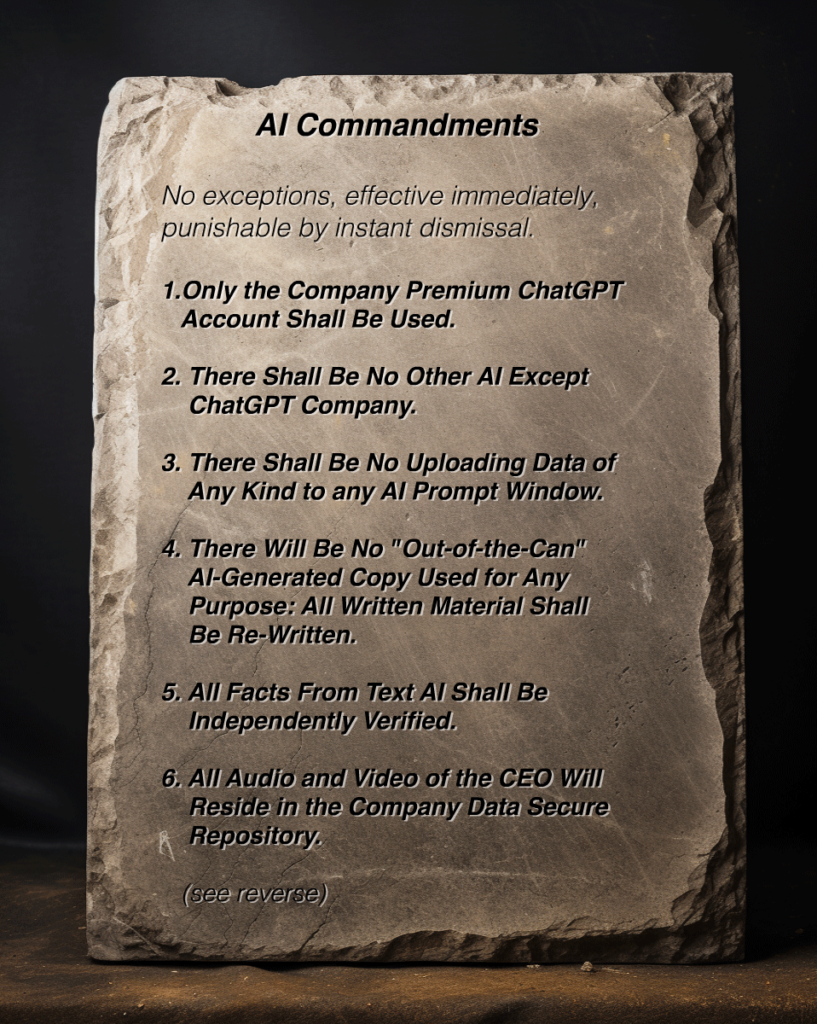
Step 4: Integration
With rules in place, teams at the ready, the leadership of the organization will likely need to adjust their expectations on general productivity for the coming months while they take on the project of AI integration. It’s an investment in the future. And, like any business transformation – whether it’s going Agile, going digital or merging – will mean that, for the starting “lift-off” phases, that people will need time, space, support and less “run” work to reach escape velocity and become AI-Powered.
Once the systems are in place and the organization has established a pattern and habit of continuous change and improvement, the workforce will begin to see the fruits of this labor take shape. SharePoint estimates that the AI-Powered worker will save about 32.5 days per year, on average, of their time[i].
This is often a time to hire the services of an AI Integration Specialist; sort of like an Agile coach, this person supports you along every step of the process.
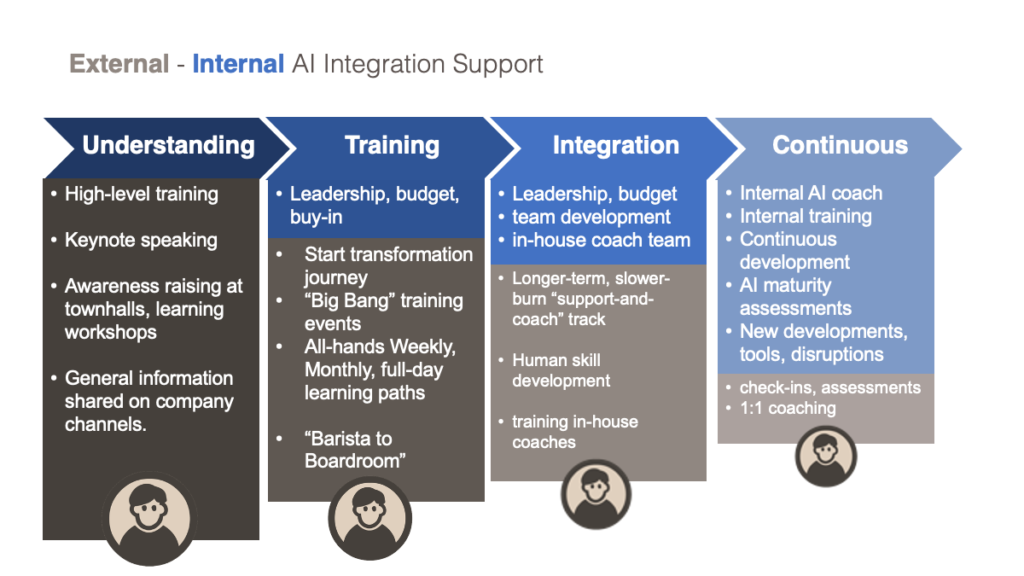
Step 5: Repeat
AI Integration is a continuous cycle that needs constant iteration, adjusting, support and training over time. Small changes, when adopted systematically, with discipline, add up to massive transformation over time. It’s important to just follow the Roadmap and look at the next phase only, try not to become overwhelmed by the enormity of the task ahead; one day at a time, incremental steps, keep it light, festive and “safe” – people will make mistakes, and having a safe space to admit them will lead to the best results.
There is always the next cycle of understanding-training-governance-integration on the horizon. There is always a cyclical investment of time and energy to match pace as the tools evolve and as customers upgrade their expectations. Communicate your AI governance clearly with your customers, no matter which stage you are in; this will put their minds at ease and build trust that comes with transparency.
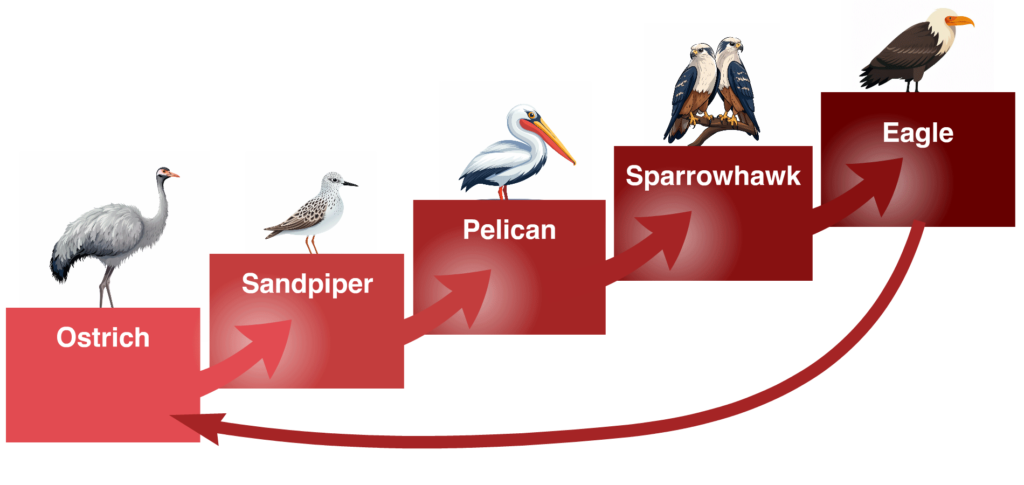
Need help with AI Integration?
Reach out to me for advice – I have a few nice tricks up my sleeve to help guide you on your way, as well as a few “insiders’ links” I can share to get you that free trial version you need to get started.
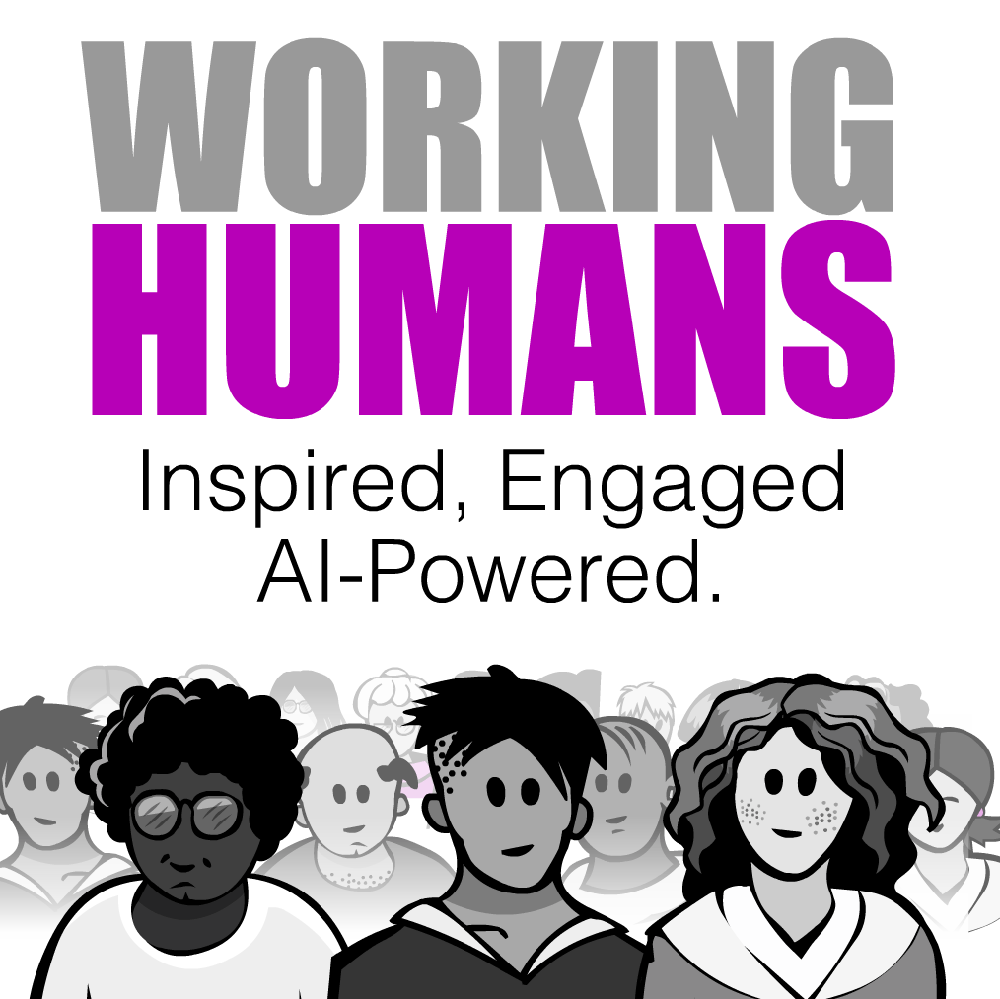
No eyeballs to read or watch? There’s a podcast for you!
- Listen to the APPLE PODCAST
- Listen to the SPOTIFY PODCAST
Search for the “Working Humans” podcast everywhere you like to listen. Twice a month, Fiona will dive into the nitty-gritty of employee engagement, communication, company culture and how AI is changing everything about how we work now and in the future. Subscribe so you never miss an episode. Rate, review and share.

About Fiona Passantino
Fiona is an AI Integration Specialist, coming at it from the Human approach; via Culture, Engagement and Communications. She is a frequent speaker, workshop facilitator and trainer.
Fiona helps leaders and teams engage, inspire and connect; empowered through our new technologies, to bring our best selves to work. Her company is Executive Storylines. She is a speaker, facilitator, trainer, executive coach, podcaster blogger, YouTuber and the author of the Comic Books for Executives series. Her next book, “AI-Powered”, is due for release in October 2023.
[i] Sharepoint (2023) “New Research: Over Half of Workers Say Generative AI Will Help Advance Their Career, but Most Lack the Skills” Sharepoint Blog. Accessed September 25, 2023. https://www.salesforce.com/news/stories/generative-ai-skills-research/#:~:text=With%20the%20help%20of%20generative,%2Dtime%20workers%20%E2%80%93%20at%20work.

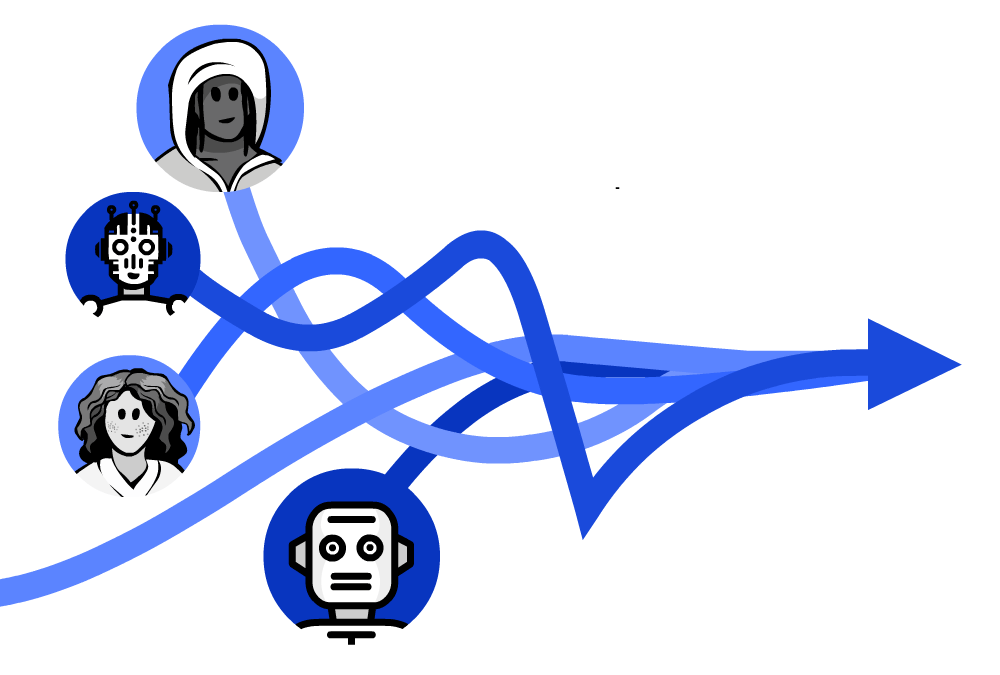
Very interesting points you have noted, regards for posting.Blog monry